Men's magazines: an A to Z
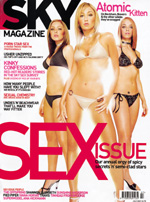
Men's lifestyle and fashion magazines, lad's magazines, glamour magazines, pin-up magazines and top-shelf magazines covered alphabetically. This page addresses Razzle to Switched On via Spick, Span and Reveille. On other pages:
Introduction
- 3D titles to Boys Toys
- Carnival to Cut
- Deluxe to Esquire
- Fable to Front
- The Gentleman's Magazine to The Humorist
- Ice to London Opinion
- Man to Maxim
- Mayfair to Monkey
- Nine to Playboy
- Razzle to Switched On (this page)
- T3 to Zoo Weekly
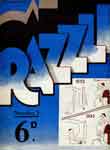 Razzle magazine issue 5 in January 1933. It was a large format title (9in x 12in) 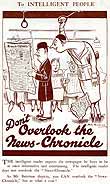 Advert on the inside cover of the above issue for News Chronicle. The cartoon was by HM Bateman
Advert on the inside cover of the above issue for News Chronicle. The cartoon was by HM Bateman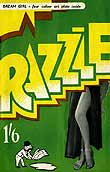 Razzle issue 6 (probably early autumn 1948), plugging its 'Dream Girl – four colour art plate inside' 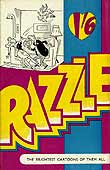 Razzle issue 47 with 'The brightest cartoons of them all' 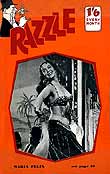 Razzle issue 82 in 1955 with Maria Felix on the cover |
Razzle [closed]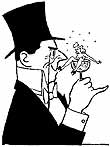 Ritz Publishing Co. 1932-1957? Ritz Publishing Co. 1932-1957?Razzle magazine started out with a large format (9in x 12in). However, it relaunched itself as a pocket title in 1935. The company changed its name to 'Ritz Publishing Co (1935)'. The cover price jumped from 6d to 1/-. This may have been a reaction to the imminent launch of Men Only. Unlike most magazines, Razzle in its smaller incarnation carried no advertising, relying on its cover price alone for income. The above image of a Razzle gent about to drink from a champagne glass containing a scantily-clad woman was used on the inside cover of issue 6 (1948) and later migrated to the front cover. As a pocket magazine, it published 'the brightest cartoons of them all' and introduced a fold-out colour centre spread of a 'dream girl' by George Davies. Most of each issue of Razzle was devoted to cartoons with two or three topless photographs. Colour was used on the cover and on the centre spread. An article in issue 16 said the office cat was called Cleavage. In the 1950s, the distinctive Razzle graphic was played down on the cover in favour of black-and-white pin-ups. Issue 97 suggests the threat posed to magazines by television, with the opening Tittle-Tattle section pondering the advent of the New Year:
The flipside of the single 'Sex and Drugs and Rock and Roll' by Ian Dury and the Blockheads is 'Razzle in my Pocket' (1977). The lyrics are about trying to steal a copy of Razzle from a newsagent (Dury was born in 1942): Razzle lives on as a top-shelf magazine published by Paul Raymond (since 1983). |
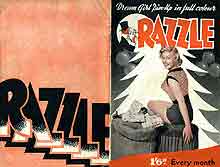 Razzle 97 (1957). The front covers evolved, but the backs
stayed the same, showing the logo in various spot colours.
The selling line on this cover was: 'Dream Girl pin-up in full cover'
Razzle 97 (1957). The front covers evolved, but the backs
stayed the same, showing the logo in various spot colours.
The selling line on this cover was: 'Dream Girl pin-up in full cover' |
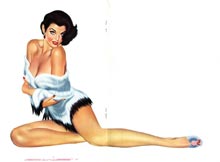 Razzle issue
97 (1957). Another thing that stayed
consistent was the centre-spread colour pin-up by George Davies.
The centre pages were printed on heavier, glossy paper of a similar
stock to the cover |
Reveille [closed]Reveille Newspapers/IPC, 1940-1979?Launched as a weekly tabloid for the armed forces and began publishing pin-ups from the start. Relaunched in the mid-1970s as New Reveille, though still as a tabloid newspaper, and later reverted to Reveille. Similar formula to Tit-Bits, which absorbed it in about 1980. Publishers:
|
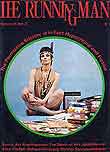 The 'revolutionary consciousness' of Running Man issue 2 was banned 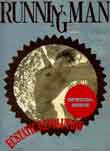 Running Man and Kypreos returned in 1969 with a combined issue 3, 4 and 5 |
Running Man [closed]Running Man Publications, 136A Westbourne Terrace, London. Printed by Holders Press, 87 Lambs Conduit St, WC1. 1968-69Christopher Kypreos, who had been a contributing editor at Penthouse, was editor and publisher of Running Man, which stated its subject matter as 'revolutionary consciousness in terms of the total human condition' and its aim as 'to wage guerrilla warfare on a mass-oriented society'. 'The editors take a considerable risk each time a new issue goes to press,' said an editorial and sure enough the police banned the magazine after the second issue. Kypreos was later acquitted of obscenity charges. The third issue (116 pages; 15/-) was combined with issues 4 and 5. Contents included:
|
 Shortlist first issue cover with Daniel Craig as Ian Fleming's James Bond |
ShortListShortlist Media, 20 September 2007-Free weekly men's magazine. Some 500,000 copies distributed in British cities, taking a similar tack to free weekly Sport in London. Headed by former FHM editor Mike Soutar, whose first company Crash Test Media developed ShortList under the working title Alpha One. The backers include Beano publisher DC Thomson – owner of Secrets, the former women's romance magazine where Soutar started aged 17 and became beauty editor. Shortlist has a website and is available as a digital magazine using the same Ceros technology as Monkey. The company later launched women's fashion weekly Stylist to consolidate the 'freemium' sector. |
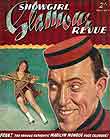 Showgirl Glamour Revue first issue portrait of Tommy Trinder, one of the most popular stars, by Stefan Baran 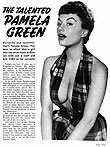 Above, the start of a 3-page feature about Pamela Green, graduate of St Martin's school of art, who found fame as a pin-up model – the 'Queen of Curves' with photographers Douglas Webb (a former Dambuster) and then Harrison Marks in Kamera. The inside back (below) was of 'French glamour model' Rita Landre (Green in disguise): they're wearing the same belt and are dressed in nothing but a scarf! The photographer was not credited but it was probably Marks. Landre was an inspiration for Michael Powell's 1960 film Peeping Tom (Green played Milly, a model) 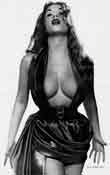 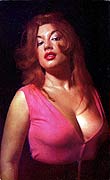 A 'Rita Landre' portrait by Harrison Marks from Fiesta in 1956 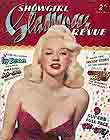 Diana Dors in issue 4. The main cover line was 'Ivy Benson and her amazing all-girl orchestra' and there were 9 full-page pin-ups |
Showgirl Glamour Revue [closed]King-Ganteaume Productions Ltd, 20 Welbeck St, W1. Printed by Samuel Sidders & Sons, 342 Hackney Rd, NW6. 2/-. 36pp. 1955-?The first issue of this magazine is intriguing and has an air of quality about it. The company behind it were 'publishers of illustrated editions' under managing and art editor M. Ganteaume. The editor was Ralph Coveney with lettering design by Alan Cowling. However, the strap across the bottom reading 'Free! The famous authentic Marilyn Monroe nude calendar!' in fact promoted a competition to win one. Readers do not take kindly to being misled in such ways. The company later published Television Glamour Review, again with Coveney as editor.Showgirl Glamour Revue carried a short story ('Understudy' by Robert Thorne), cartoons, Hollywood, music and revue-theatre articles (Pigalle cabaret and Percival Murray's Cabaret Club) and pin-ups, including Diana Dors, British starlets Cleo Rose and Jill Adams, pin-up model Pamela Green, 'French model' Rita Landre (in fact Green in disguise), singer Lorrae Desmond and Tiger Joe Robinson. A 20-year-old Michael Winner wrote a showbusiness gossip column (Winner's World). The back cover carried an advert for Cavalier magazine published by L. Miller & Son. A strip-cartoon was based on the script of the Rank film Mad About Men and its character Caroline Trewella. It was drawn by Peggy Adams. Green’s character of Rita Landre intrigued director Michael Powell when he was researching his 1960 film Peeping Tom. He copied the Parisian set Green had built in which to photograph the character and Green played Milly, a model who is murdered in the controversial film. A three-page article in Showgirl Glamour Review featured Green posing in nothing but a scarf and a belt. In the same issue was a photograph of Green disguised as Landre, in the same belt but a longer scarf. An article (‘High-powered Rita’) described how Landre was born in France in 1934 to a Dutch mother and Spanish father, who were both circus trapeze artists. Landre had followed in their footsteps aged 15 before going on to the Folies Bergère and becoming a top-line glamour model. The article finishes:The cover was a fine illustration by Stefan Baran of Tommy 'You Lucky People' Trinder. (He is credited with coining the phrase 'Overpaid, overfed, oversexed and over here' about US troops in Britain during the second world war). A three-page article is based on his return to Britain from touring Australia to play Buttons with Sonya Kaye as Cinders in Claude Langdon's Cinderella on Ice at London's Empress Hall. This dates the magazine to 1955. The writer rebuffs the view in a recent Picture Post that Trinder was out of key with the decade and lost in the 1940s. In fact, Trinder went on to host independent television's Sunday Night at the London Palladium for its first few years from the first week of commercial television in September 1955. Compare with Spice below. Other titles that looked to the pin-up side of theatre in the 1950s were Show and Showgirls |
 Zoo Sie7e first international edition of men's weekly Zoo |
Sieze (Spain)Focus Ediciones/Emap, August 2005-The first international edition of Emap's men's weekly Zoo, launched in Spain. It is published in partnership with Focus Ediciones (part of Swiss publisher Edipresse), which publishes FHM in Spain under licence. Weekly Sie7e (Seven) was already on the shelves but it was re-branded as Zoo Sie7e. The target circulation for Zoo Sie7e was 100,000 within 18 months (FHM sold 250,000 copies in Spain). Emap profile |
 Sky last issue |
Sky [closed]News International/Emap, February 1987-2001Rupert Murdoch's News International magazine division launched the pan-European youth magazine Sky, in a joint venture with French group Hachette, led by publisher Peter Jackson. Sky started out as a fortnightly for 16 to 25-year-olds, but failed to meet a 200,000 sales target and was cut back to a monthly in November. Its audience was refined to 18 to 22-year-olds and was increasingly influenced by the lad's mags in the 1990s. Murdoch pulled out of magazine publishing, and the Hachette partnership, which included Elle, was taken up with Emap, until it was dissolved in 2002. Sky closed in 2001. Emap profile |
Snug [closed]Licensed Publishing, London, Nov/Dec 2002-?The catchline 'A haven for drinkers and thinkers' called readers to this title, which editor Nick Bradshaw described as 'a magazine from a pub'. Its menu of sport, politics, religion, health, fashion and travel marked a change from the bimbo-infested launches of the previous decade. Jarvis Cocker was the cover interviewee. Snug received backing from the Just Customer Communication agency. |
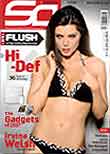 So
/ Switched On wanted to be a men's gadget title |
So / Switched On [closed]Galaxy Publishing. Jan-Apr 2007Relaunched version of Ice that tried to become a mainstream men's gadget title but folded after 3 issues. |
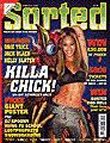 Sorted for teenage boys lasted just four issues |
Sorted [closed]Sorted Communications, Brighton. February 2004-May 2004Monthly for boys aged 12-16. The first issue of Sorted carried an A1 poster for Whiplash computer games and the film School of Rock. The editor was Martin Klipp. Sorted closed after just four issues. The fifth issue, featuring a cover interiew with David Beckham, was at the printers. |
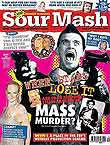 Sour Mash: first of just two issues (November 2003) |
Sour Mash [closed]Mash Communications, High Wycombe, Bucks. November 2003-Feb 2004 (2 issues)Described in the trade press as a men's magazine aiming to be a cross between Private Eye, early Loaded and Viz, the launch issue of Sour Mash felt more like a cross between Viz and Heat. The company was founded by four ex-IPC executives: Andy McDuff, Alan Lewis, Nick Taylor and Mark Jones. Johnny Sharp was the editor. The FT's Creative Business magazine quoted McDuff (who was head of men's division when Loaded launched) criticising the 'super tanker mentality' of IPC and Emap : 'IPC would never launch Sour Mash. It's too radical, too small and doesn't meet any portfolio strategy." (Four Emap executives had launched a similar breakaway company to launch Word.) Best visual joke: acerbic writer Julie Burchill – who established her reputation in the punk era at IPC's NME – digitally enhanced to look like Winston Churchill. Print run of 60,000; expecting to sell 50,000 of first issue. Sour Mash needed to sell 25,000 copies a month to break even, but it only made it to two issues. Writer Nick Tolson has put some of the Sour Mash contents online |
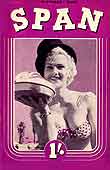 Joya Radcliffe was the cover girl for the first issue of Span in 1954.
She was the assistant to a US clown called Go-Go, who was featured
in a 6-page photo shoot 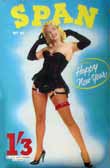 Span from 1958 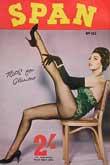 Span in 1962 with Joan Collins on the cover |
Span [closed]Town & Country Pubs (SoCo), Croydon, Surrey. September 1954-Oct 1976Editor and manager: R.T. Staples. Advertising: JDW Hancock. Pocket pin-up magazine. The first issue of Span featured:
SoCo – as the men's magazine publisher has become known – also published Fanfare and 66. Joan Collins covers |
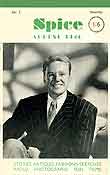 MGM actor Van Johnson was on the cover of Spice |
Spice [closed]Spice Magazine, 29 Tolmers Rd, Cuffley, Herts. August 1946-?The cover of this pocket format theatrical magazine showed an MGM actor, Van Johnson. The contents were listed as: stories, fashions, sketches, radio, photographs, fun and films. It included an article on women's fashion in Hollywood, again using studio shots. The centre pages were devoted to an advert for Vivian van Damm's 'Revudeville' at the Windmill Theatre (in its 15th year). Strangely, the inside front cover carried a statement: 'In order that our readers may be given the maximum amount of good reading material, consistent with the supply of paper at our disposal [wartime rationing will still have been in force], all advertising material has been excluded from this, the introductory issue of SPICE.' Note also the odd use of spot green – red ink ran out in 1944. Very strange. Compare with Showgirl Glamour Revue |
|
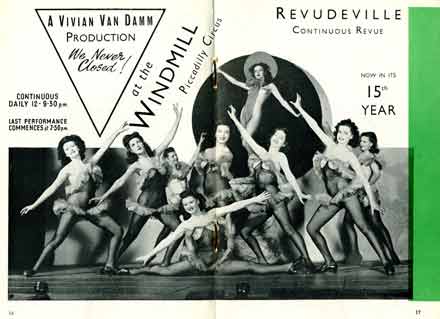 Centre spread of Spice featured
a 'tableaux vivant' from Vivian van Damm's production of Revudeville at the Windmill theatre in 1946.
'We Never Closed' refers to the fact that the theatre stayed open right through the Blitz.
Paul Raymond took over the theatre in 1974, a time when he also took over many established men's magazines
|
||
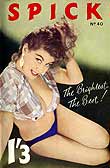 Spick from 1957 (issue 40)
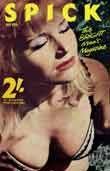 Spick issue 156 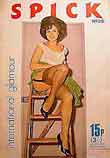 Spick from May 1971 (issue 210) |
Spick [closed]Town & Country Pubs (SoCo), Croydon, Surrey. December 1953-1973Spick was a UK pocket pin-up magazine that came out at the same time as Playboy in the US. Aimed at a very different audience, with its content based on 'girl next door' photographs. Film stars were featured in SoCo's other titles Span (above) and 66. The magazine published at least 234 issues (May 1973) and teamed up with sister title Span for annuals and extra issues. |
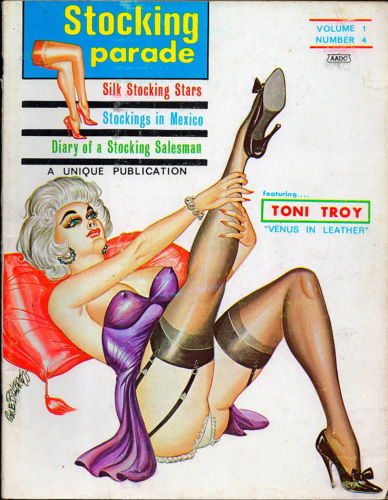 Stocking Parade from February 1966 (issue 4) 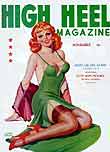 High Heel from November 1938 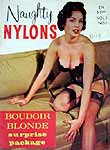 Naughty Nylons (November 1962) |
Stocking Parade (US)Stocking Parade (Unique Publishing) was a 1960s US title whose early covers were reminscent of the country's girly magazines dating back to the 1930s. Such titles influenced the British market; others were distributed in the UK; and the content was sometimes republished by British publishers. Similar titles included High Heel, Naughty Nylons and Leg Show. |
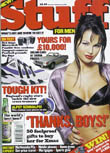 Stuff focuses on technology |
StuffDennis/Haymarket. December 1996/January 1997Stuff is a technology magazine for men. In 1999, Haymarket Dennis sold Stuff to Haymarket. Dennis profile Haymarket profile |
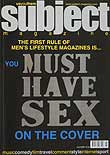 Subject first issue with the page 3 follow-up below 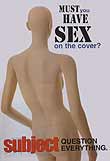 |
Subject [closed]Stable Publications, London. March 2001-?Men's lifestyle magazine edited by Ross Cotttingham. Lacked the sophistication in presentation – and undoubtedly the budget – to compete in a cut-throat market. Subject tried a more thoughtful approach, as demonstrated by the cover statement, 'The first rule of men's lifestyle magazines is ... you must have sex on the cover', which was questioned on page 3: 'Must you have sex on the cover? Subject: question everything.' |



